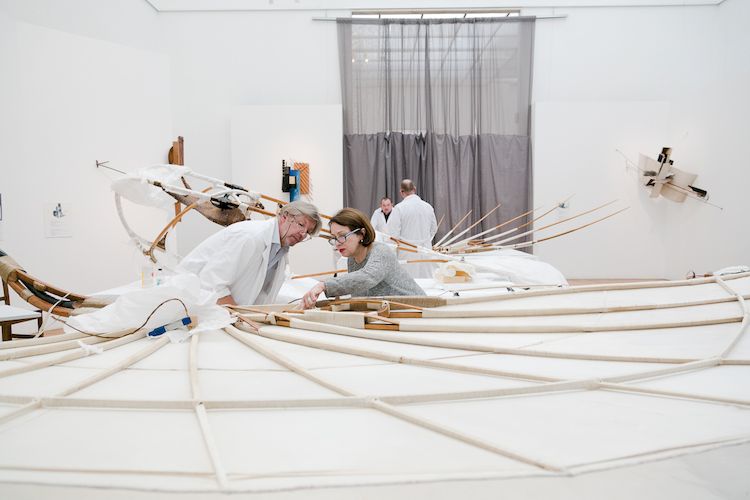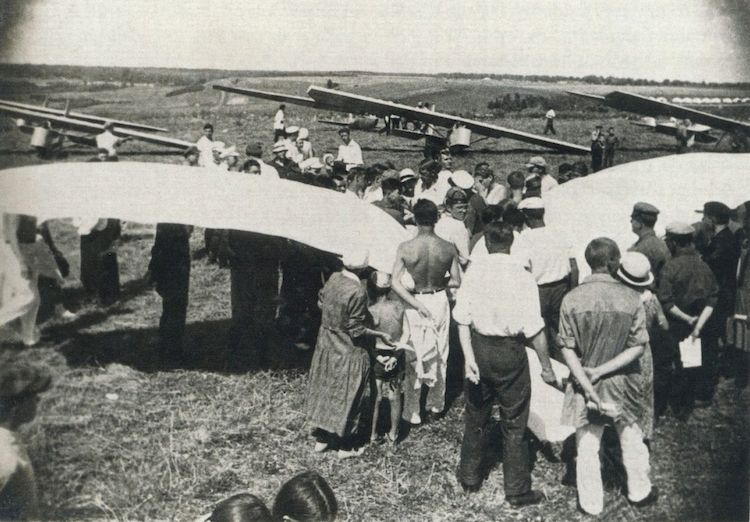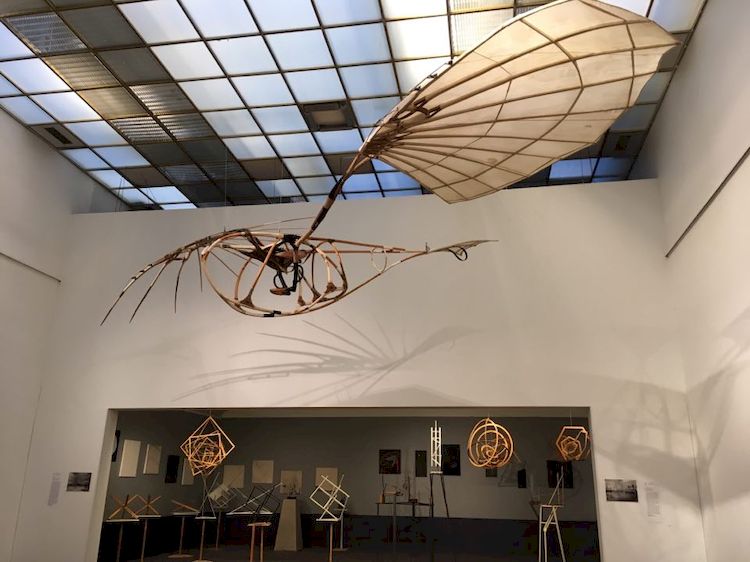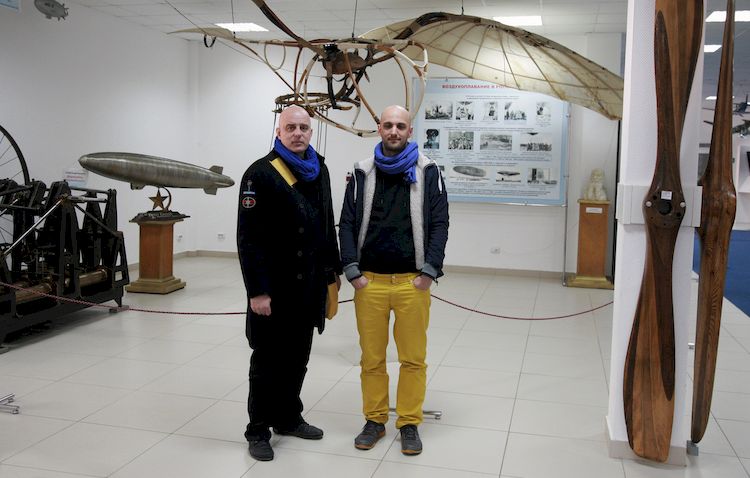The “Letatlin” resumes its flight
Published 20 February 2018 by Ewen Chardronnet
Forgotten, found again, restored, Tatlin’s flying machine takes back its place in art in Moscow. Miha Turšič, who identified it in a Russian military museum, tells us about its revival.
Tretiakov Gallery, the biggest museum in Moscow, early December 2017, a few weeks after the centenary of the Bolshevik revolution. The Gorki park museum, which has one of the most important collections in the world, announced an exceptional occasion in the history of art but also of the dream of human flying: the arrival of Vladimir Tatlin’s Letatlin flying machine in the rooms reserved for 20th century art.
The ornithopter designed by Tatlin from 1929 to 1932 had disappeared. It had been more or less abandoned for twenty years in a warehouse belonging to the Monino Russian Federation Central Air force museum, next to Star City, the Youri-Gagarin cosmonaut training center fifty kilometers away from Moscow. It was the KSEVT, team, the space culture center in Slovenia (of which we told you about), that by chance came across the machine in a precarious state during a protocol visit to the Monino museum in April 2014 and sent the alert. Like a phoenix rising from its ashes, the restored machine hovers today in the collection of the Tretiakov gallery.

A poetic machine
The word Letatlin is formed from the verb letat (fly), associated with the name of its creator, Tatlin. In the Stalin years, Tatlin, one of the major artists of the constructivist movement of the Soviet revolutionary years, who had imagined a 400m high tower as a Monument to the Third International, escaped reality in an ultimate dream: to fly. He designed his ornithopter as an organic machine inspired from birds and affirmed the necessity to think about the future of human flying according to biomechanical and organic criteria.
Not very rational, not really flying, more bringing to mind Icarus and Leonardo da Vinci than aviation at the time, the Letatlin was a project that his author presented seriously as an object of domestic consumption for the new Soviet man, that would supply the masses with affordable flying equipment and make air travel as commonplace as bicycle rides. Subtly mystifying, Tatlin declared flying simply consisted in coming back to an ancestral human experience that evolution had made it lose and that he intended to give back to the modern man. Poetic machine, the Letatlin came at the dawn of the great purges of Stalinism to remind people of the metaphysical dream of flying and the dreamlike dimension of desires at that time but also its failures and the need to escape from them.

Tatlin built three versions of his machine. It was Letatlin n°3 that was found. It would have reached Molino in 1996 after being damaged on the way back from a presentation in an exhibition in Athens and was left there, abandoned in the context of complicated years following the collapse of the USSR. Its arrival twenty years later at the Tretiakov gallery represents an occasion in contemporary artistic Russia and shows that the artistic avant-garde, the dream of flying and the successes of the Russian space program count among the prides of national post-Sovietism.
Miha Turšič, director of KSEVT until 2016, member of the collective Postgravityart and today in charge of the development of the Waag Society in Amsterdam, spotted the Letatlin in the corridors of the Monino museum in April 2014. Interview.

How did you rediscover the “Letatlin”?
We had been working with the training center for cosmonauts for twenty years or so. One must understand that the Monino museum is a military museum and it isn’t that easy to visit it. The foreign affairs department of Star City wanted to bring us there to show us the biggest plane, the biggest helicopter, the fastest plane and many other legendary flying machines. One day in February 2014, they took us to the historical part where one can see pioneers’ flying machines, since the Russians went into aeronautics very early.
While the group was in discussion, I went ahead, getting a bit lost in the aisles of the museum, and suddenly I found myself face to face with a machine that looked like a plane but wasn’t one. I knew of the Letatlin insofar as we had extracted elements of its organic looking design for some of our projects. And there it was right in front of me! This was an enormous surprise. We immediately asked if they knew what they had there, one of the most iconic works of 20th century art. They told us: “Yes, it’s an old Russian artist who built sort of flying machines rather like Leonardo de Vinci.” They had no idea of the importance of the piece they had there. They considered it as best as an experimental flying machine that had never flown. They had just retrieved it a year earlier from the museum storeroom where it lay in bits in a corner, deteriorated, really damaged, and they had reassembled it to hang it in this section of their museum.
With no mention of its author?
Yes, Tatlin was mentioned, but with no context. They only knew he had built two or three, that he had carried out a trial flight that hadn’t worked out. They knew nothing about the pertinence of the object, exhibited it as something interesting corresponding to the early years of aviation, without knowledge of its artistic value. We were rapidly overwhelmed with stress to see such a work of art in this state and started to think about what to do to find a solution. It seemed obvious that a renovation was necessary and we asked ourselves what to do for the Letatlin to be moved into an artistic context.

How did you go about having it restored?
During our next visit the same year, we carried out various actions to find a way of renovating it, be it in Russia or outside Russia. We even imagined taking it back to Slovenia or Croatia. I also recall having carried out the visit with an aviation expert from the Russian Science Academy so that he would understand what type of object we were faced with. The story gained credibility and the Monino museum and the Tretiakov gallery finally found an agreement for its renovation. We went to Moscow at the end of December 2017 to meet the curator of the museum and we were satisfied to see it displayed in the 20th century art collection. The Letatlin finally found the perfect place for its presentation to the public.
According to you, why is it so important?
In spirit, it could be what is closest to our artistic satellite project under development with Postgravityart. The understanding of the position of man in the space technological context is crucial today. Letatlin, with its organic shapes, is as important for cosmonautics as it is for avant-garde art. With this machine, Tatlin also questioned human biomechanics and the way we function in our environment. He raised the question: what does it mean to be human?
Miha Turšič has coordinated the space workshop “Out of the Cradle” at the Waag Society on February 27
